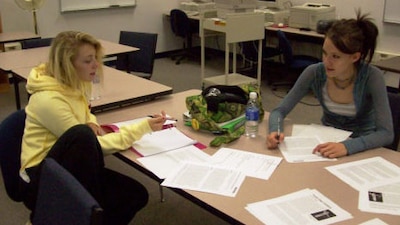
Rapid growth in Colorado’s online schools slowed this past fall though virtual programs still saw a double-digit increase in enrollment.
The number of full-time students attending online programs across the state grew 12.5 percent to 13,128, or the equivalent of the 19th largest school district in Colorado.
It’s the lowest rate of growth in the past six years, with the singular exception of 2007. That’s the year virtual enrollment flat-lined after a scathing state audit of online programs.
Enrollment jumped 48 percent in fall 2006 and rebounded, after the audit, with a 26 percent increase in fall 2008.
Pamela Ice, director of online learning for the Colorado Department of Education, said anecdotal reports from schools led officials to project higher growth this past fall. She said it’s not clear why that growth didn’t materialize.
Some schools, such as GOAL Academy along the Front Range and Kaplan Academy of Colorado in Rifle, reported huge leaps in enrollment, of 118 percent and 93 percent respectively, from 2008 to 2009.
Other schools, including Hope Online, previously one of the state’s fastest-growing programs, saw enrollment declines. HOPE’s enrollment dropped 10 percent, according to Ice’s report, which was released Friday.
Hope Online CEO Heather O’Mara said the online enrollment slowdown isn’t necessarily bad news.
“I think it’s really a result of the number of choices that are available across the state of Colorado and, honestly, a number of districts that are offering online options as part of their program,” she said.
“I think it’s a great change from a policy perspective for our state because we’re continuing to add more choices for kids and parents so kids can be successful.”
Achievement indicators lag state
Ice’s office was created by state lawmakers in response to the audit, which ripped former Colorado Education Commissioner William Moloney for lack of oversight of online programs.
Her 2009 report, only the second of its kind, is filled with data demanded by worried lawmakers.

Among its findings – student achievement and graduation rates in most of the 24 online programs reporting data for 2008-09 lag statewide averages by wide margins.
For example, the number of online students achieving at grade level in reading, writing, math and science on state exams is 10 to 26 percentage points lower than their peers in traditional schools.
Math shows the biggest gap, with 28 percent of online students achieving proficiency compared to 54 percent of their classmates in brick-and-mortar schools.
One reason may be that many students enrolling in online programs fail to stick with them.
The Colorado Distance and Electronic Learning Academy or CDELA, for example, had 513 students enrolled in fall 2008 and only 225 still enrolled in the spring. That’s a drop-off or non-completion rate of 56 percent.
Another online program, Insight School of Colorado, had a non-completion rate of 47 percent, followed by Vilas Online at 25 percent and Hope Online at 24 percent.
Showcasing glimmers of progress
Still, there were signs of progress in online education from 2008 to 2009.
The graduation rate for online students was 34.9 percent in 2009, up from 23.1 percent. That compares to a statewide graduation rate of 74.6 percent in 2009.
The number of online students scoring proficient or advanced on state reading tests grew, from 51 to 54 percent in 2009, while the numbers scoring unsatisfactory declined from 20 to 16 percent.
Some online schools are even outperforming statewide averages in some areas.
Branson School Online, one of Colorado’s first online programs, had a higher percentage of students at grade level in reading, writing and science in 2009 than did brick-and-mortar schools statewide.
The tiny district in Las Animas County is serving 447 students from 82 other districts in its online school and 30 students from its own community in its traditional building.
“Building that student-teacher relationship is definitely the most important part of the education process,” Superintendent Larry Birden said. “So we try our best to make every student think they’re special.”
The online school has a teacher-student ratio of 20-to-1, two counselors who track student progress and tutors who intervene when kids fall behind.
Monitoring online quality, growth
Ice said several online programs reported steps like those taken in Branson – the hiring of a second counselor, the use of programs such as Response to Intervention to monitor student needs.
“Although student achievement is in many cases below the state average, we’re seeing some forward movement,” she said Monday. “We realize this is not something that is going to happen overnight.”
The state report does contain some eyebrow-raising numbers, listing student-teacher ratios as high as 1-to-98 for Hope Online and 1-to-317 – or one part-time teacher for 174 students – for Kaplan Academy of Colorado.
Kaplan officials said that number is in error and they’re working to track down its source. In 2008-09, the school had 6 full-time teachers, 14 part-time teachers and two academic coaches, said spokeswoman Michele Pore.
O’Mara, with Hope, said the ratio of licensed teacher to students may be 1-to-98 but the adult-to-student ratio is 1-to-18. Hope uses adult mentors in learning centers across Colorado to assist students.

The report also questions the budgets of some schools, which spend far more on purchasing and promoting curriculum than on direct student support.
Colorado Virtual Academy or COVA, for example, lists 17 percent of its budget as salaries and benefits compared to 89 percent for Academy District 20’s Online High School and 68 percent for Branson.
Ice said the data now goes to state lawmakers and she’ll follow up with individual reports to each program.
“What we do have statutory authority to do is to ask them for a plan of improvement, a corrective action plan of improvement,” she said.
But Ice added that it’s really up to the authorizers – typically the districts partnering with the programs – to crack down on issues of concern.
“We’re not trying to close down programs but rather help them improve,” she said. “The authorizing district is really the entity that’s responsible for monitoring and making sure that things are as they should be.”
Online growth expected to continue
Last month, it was the authorizing entity, the state Charter School Institute, that ordered the shuttering of CDELA, one of the state’s larger online schools.
Institute board members, in their resolution authorizing the closure, cited a host of issues, from failure to make academic gains to incomplete enrollment records to poor financial planning.
CDELA’s enrollment dropped 12 percent from 2008 to 2009, down to 455 students.
Those students should have no trouble enrolling in another online program in 2010. Colorado now has 19 programs that operate statewide and four more are seeking approval to do so.
And the state is continuing to draw attention from national online networks, which tend to partner with rural districts and recruit across the state.
Kaplan, which partners with the Rifle school district, offers online high schools in seven states. The Insight School of Colorado, which partners with the Julesburg district at the state’s northeast tip, has virtual high schools in nine states.
Insight’s enrollment, at 976 this past fall, dwarfs that of its partner district, which has 263 students.
Perhaps ironically, the once rapid growth of Hope Online, which helped trigger the state audit, has stalled. Hope’s enrollment has declined in each of the past three years, to 2,839 this fall or about 1,000 fewer students than its peak year of 2006.
The number of learning centers has declined from 79 to 50. The program continues to work with the highest-poverty student enrollment of any online school.
O’Mara said the growth of options in urban areas such as Denver and Aurora has contributed to the declining student count, as has greater quality control over learning centers by Hope.
She said she welcomed the greater accountability that followed the audit but wonders if it’s time for another look.
“I think there’s probably room to step back and take a look at these rules and see what might be working and not working,” O’Mara said, “and what’s improving education and accountability and what parts of the law might be stifling innovation …
“We’re more accountable in many ways than traditional public schools because of the additional reports we’re required to file and the additional scrutiny we continue to be under.”
Nancy Mitchell can be reached at nmitchell@pebc.org or 303-478-4573.
To learn more:
Click here to read the Colorado Department of Education’s Online Enrollment Report.
